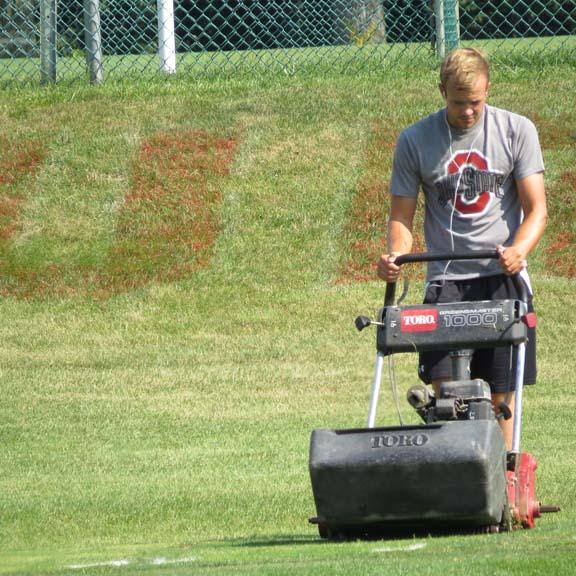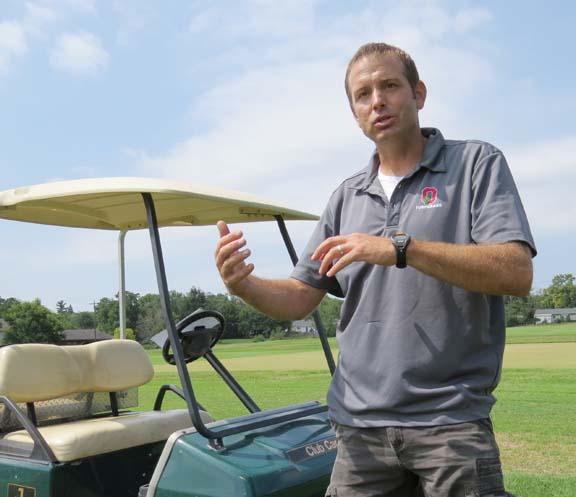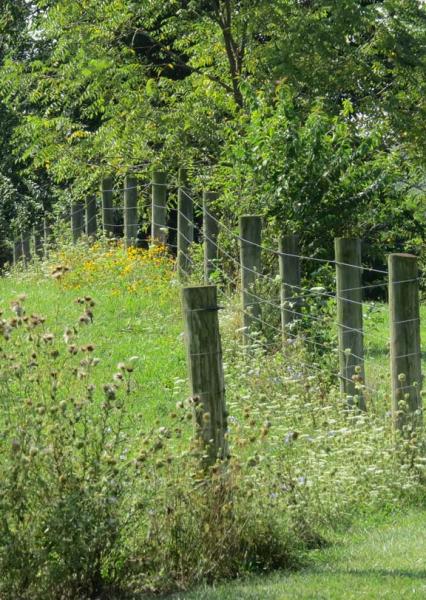 Talk to enough people in the business of golf turf maintenance, and sooner or later someone is bound to mention how it's one that is built on relationships. Nowhere is that more apparent than at the Ohio Turfgrass Foundation Research and Education Facility at Ohio State University.
Talk to enough people in the business of golf turf maintenance, and sooner or later someone is bound to mention how it's one that is built on relationships. Nowhere is that more apparent than at the Ohio Turfgrass Foundation Research and Education Facility at Ohio State University.While many university turf programs are supported by a separate turf association, it's rare when both entities are located in the same municipality. It's even more rare when they call the same campus home. The odds of them coexisting in the same building? Almost infinitesimal.
Almost.
At the OTF research facility on the northwest corner of the OSU campus, the member organization and the university's turf research share the same building. Construction of the building in 1996 was funded by OTF, which has since donated the property to the university. The building houses offices for OTF and Ohio State staff, meeting facilities, a mixing lab for the university's research team and storage space for chemicals and mechanized equipment.
"When we funded the construction and donated the research facility to Ohio State back in 1996, the board at the time had the foresight to include an option for us to occupy space to conduct our business," said OTF executive director Brian Laurent. "We finally executed this option back in April. Our proximity to the team has already resulted in more timely communication to our members and is helping us develop new tools for turfgrass managers. Ultimately, being able to interact with Ohio State faculty and staff on a daily basis will only improve our ability to connect the industry with academia."
OTF's mission is to raise funding to promote turfgrass research and education. Much of that research and education takes place on site with the help of OSU's turf faculty and staff. During its 53-year history, OTF has contributed nearly $5 million to support research and educational outreach throughout Ohio, including through the annual OTF Conference and Show each December as well as a field day held each August, both of which are held in concert with OSU's turfgrass researchers, staff and students.
 Matt Williams is a 2001 OSU turfgrass science graduate who worked for Doug Gallant on the Cincinnati Reds grounds crew for more than two years and spent four seasons as head groundskeeper for MLS's Columbus Crew before becoming the research center's program coordinator in 2007. As a university employee stationed at the research facility, Williams, 38, is its defacto superintendent and equipment manager, and as such he oversees ongoing research projects and maintains the property's mechanized equipment.
Matt Williams is a 2001 OSU turfgrass science graduate who worked for Doug Gallant on the Cincinnati Reds grounds crew for more than two years and spent four seasons as head groundskeeper for MLS's Columbus Crew before becoming the research center's program coordinator in 2007. As a university employee stationed at the research facility, Williams, 38, is its defacto superintendent and equipment manager, and as such he oversees ongoing research projects and maintains the property's mechanized equipment."We wouldn't be here without (OTF)," Williams said. "I'm not exaggerating. They built the building, and they fund the operation of the building, too.
"They're a separate entity, but a lot of their mission involves the OSU turf program. It's been a good partnership for us."
"There is no question that OTF and Ohio State go hand-in-hand," Laurent said. "Our support over the years has provided opportunities for research trials, outreach and even faculty and staff members. In return, the turf team serves as an excellent resource to our members, stakeholders and the industry as a whole. It's a true partnership with a very bright future now that we share space."
That financial support helps fund research projects involving several turf varieties scattered across the facility's 25 acres.
Current projects include a recent field day demonstration of the Koro scarifying system on Penncross creeping bentgrass, which has become a preferred method for restoring European soccer fields.
Penncross is the most prevalent variety of turf found at the research facility for many reasons. It's susceptible to disease and insect pressure and is very responsive to nutrients, making it a good barometer for fertility studies. It also doesn't require intense management common to some newer varieties of bentgrass.
"We can get dollar spot like it's our job," Williams said.
"We over-fertilize and we under-fertilize. We definitely don't do things by the book.
Despite the relatively northern location of the OSU turf research farm, Bermudagrass is the second-most common variety under management there, and professor John Street, Ph.D., has been growing it in Columbus for 15 years.
Currently, professor Karl Danneberger, Ph.D., is overseeing a graduate research project that is examining whether any one of several types of Bermudagrass - Northbridge, Latitude 36, Riviera and Patriot - are an option for summertime golf course practice range tees or high school athletic practice fields in Ohio.
The facility also has a state-of-the-art Hunter irrigation system that delivers water only where it's needed and when.
"We have 40 different zones," he said. "It is so precise we can conduct drought research next to an area that has been over-irrigated."
Unlike many turf research complexes that are tucked away in a far-off corner of town, the OTF/OSU facility is located smack in the middle of a suburban neighborhood. And that means being a good neighbor. When several black walnut trees that were dying needed to come down for the sake of appearances and safety, Williams sent letters to about 100 nearby homeowners.
"When you have one tree, it's no big deal, but we're talking eight 40-foot-tall trees that were diseased that needed to come down. They looked bad," Williams said.
"We know we have to have proactive communication with the neighbors. We sent letters to all of them telling them what we were going to do, and we didn't hear anything from anyone."
 Native flowers that hug an old fence and a blue heron hunting fish in a quiet pond just inside the entrance make it seem like one is in the country rather than on the outer edges of one of the nation's largest universities. Indeed, Williams, along with his boss, OSU professor Karl Danneberger, Ph.D., and Laurent in the OTF office, like to keep the entrance to the research center neat and tidy. That means keeping the front entrance weed-free, or reasonably so. That can cause a conflict at times, however, with other researchers who view weeds as a thing of beauty.
Native flowers that hug an old fence and a blue heron hunting fish in a quiet pond just inside the entrance make it seem like one is in the country rather than on the outer edges of one of the nation's largest universities. Indeed, Williams, along with his boss, OSU professor Karl Danneberger, Ph.D., and Laurent in the OTF office, like to keep the entrance to the research center neat and tidy. That means keeping the front entrance weed-free, or reasonably so. That can cause a conflict at times, however, with other researchers who view weeds as a thing of beauty."If Dr. (David) Gardner finds an outbreak of chickweed, he doesn't want me to do anything about it," Williams said. "He wants to study it."
Being a good neighbor has its rewards. When a waterline on the northwest corner of the property ruptured, it was a neighbor who called Williams in the middle of the night to tell him.
"We recognize the neighbors are there, and I'll go and chat with some of the ones I know," Williams said. "And if something is going on here that doesn't look right, they'll let me know, like the time we had a 4-inch mainline break and one of the neighbors called me at 1 in the morning to tell me we had a flood out here."
While the OSU/OTF relationship promotes research and education for those working in the industry, it also is a laboratory for students enrolled in the university's turf program.
Here, students can conduct graduate-level research projects, gain practical experience by helping maintain turf and also get their hands dirty by assisting Williams in maintaining mechanized equipment. With more than 50 pieces of equipment, Williams has students conduct preventive maintenance and manage a parts inventory and ordering system.
"I have the students do a lot of the preventive maintenance on the equipment," Williams said. "They have fun doing it.
"There's nothing I won't let the students do. They're not going to be spraying or riding on mowers right away, but they'll get the opportunity to do whatever it is they want to do. If they come to me and tell me there is something they want to do, we'll make it work."

